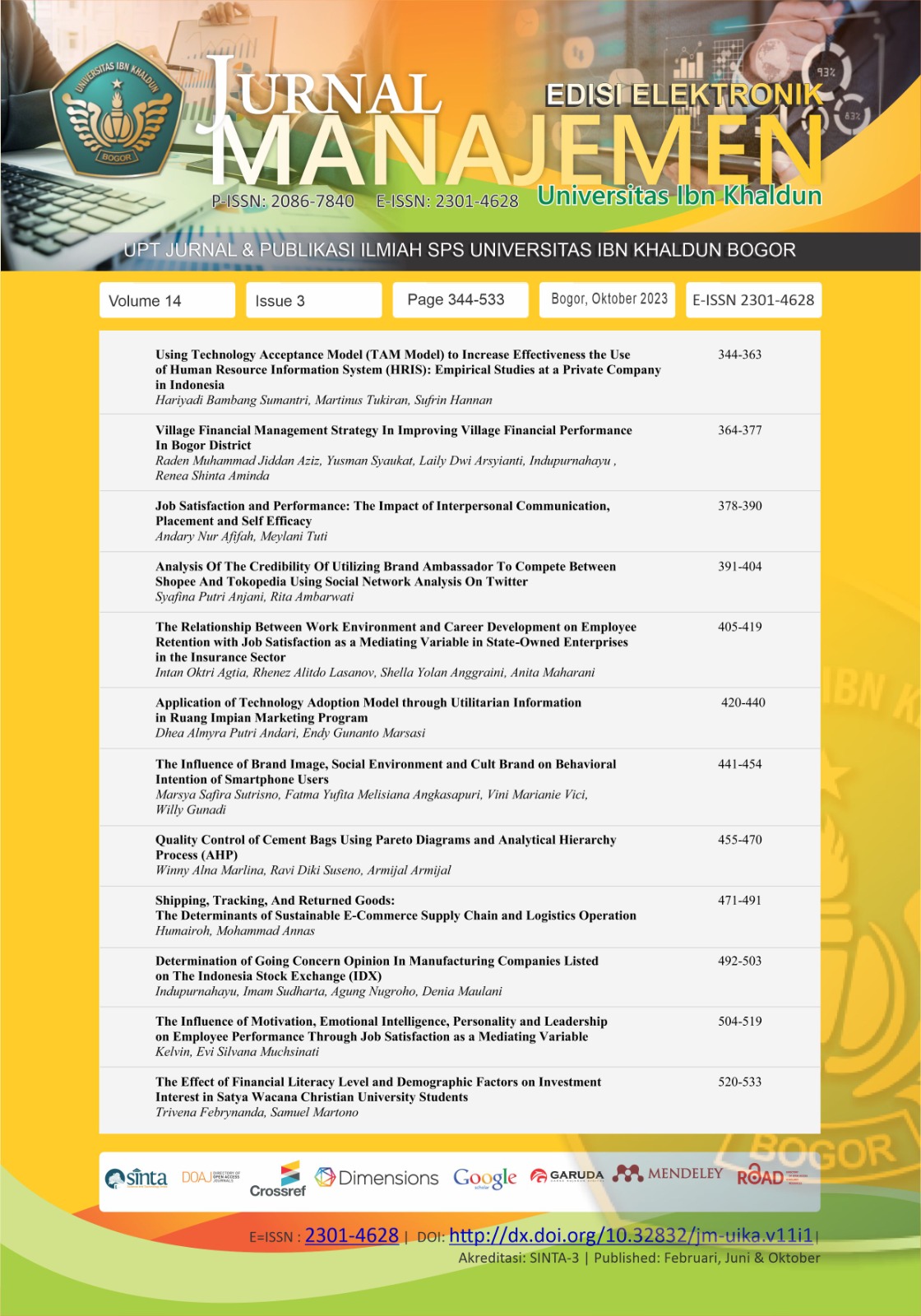Quality Control of Cement Bags Using Pareto Diagrams and Analytical Hierarchy Process (AHP)
DOI:
https://doi.org/10.32832/jm-uika.v14i3.9048Keywords:
Pareto diagram, quality control, defective products, defects.Abstract
A cement company in Bengkulu which has been operating and producing premium quality cement since April 2015 is experiencing quality product issues, particularly regarding its cement bags. Raw material was the largest defect contributor, accounting for 65% of the total defective bags with the causing criteria were raw materials that did not meet specifications, no hole at the end of the valve, bags with poor adhesive strength, oversized bags, oversized pores of the bags, and the valve holes were too tight. Other defect contributor was related to machinery factor that contributed to 30% of the total defective bags with the causing criteria were conveyor belt sway, spout kick accuracy issue, poor guide plate accuracy, and loading machine with brake issues. Another defect contributor was related to human factor, that contributed to 5% of the total number of defects caused by human error such as lack of focus and fatigue. Pareto diagram was one of the seven tools in quality control. Pareto chart was a special type of bar chart where, each bar represented a different category or part of a problem. The sample used in this study was the number of defective cement bags (40 kg and 50 kg of cement bags) for the period of January-December 2019.
References
Al-Baldawi, Z., & Ali Hussein, I. (2020). Integration Pareto Distribution and Pareto Analysis to Analyse and Diagnose Defects and the Root of Causes for the Air-Cooling Motor. Diyala Journal of Engineering Sciences, 13(1), 49–57. https://doi.org/10.24237/djes.2020.13105
Andalia, F. (2017). Implementation Analytical Hierarchy Process on Airplane Ticket Booking Application Selection with Software Quality Requirements and Evaluation ISO/IEC 25010:2011. International Journal of New Media Technology, 4(2), 126–130. https://doi.org/10.31937/ijnmt.v4i2.660
Ernita, T. (2016). Analisis Pengendalian Kualitas Produk Kantong Semen Pada Line IV Pabrik Kantong PT Semen Padang. Jurnal Sains Dan Teknologi: Jurnal Keilmuan Dan Aplikasi Teknologi Industri, 16(1), 1. https://doi.org/10.36275/stsp.v16i1.48
F. Geraldy Lumempouw, Sifrid Pangemanan, M. P. (2017). The Analysis of Internet Services Using Analytical Hierarchy Process Method In Manado (Case Study: Telkomsel, Xl And 3). EMBA, 5(3), 3975–3984.
Hadi Sulistyarini, D., & Nur Cahyawati, A. (2016). Analisis Pengendalian Kualitas Proses Pengantongan Semen. Journal of Engineering and Management Industial System, 4(1), 70–76. https://doi.org/10.21776/ub.jemis.2016.004.01.8
Handoko, A. (2017). Implementasi pengendalian kualitas dengan menggunakan PDCA dan Seven Tools pada PT. Rosandex Putra Perkasa di Surabaya.
Haryanto, E., & Novialis, I. (2019). Analisis pengendalian kualitas produk bos rotor pada proses mesin CNC lathe dengan metode seven tools.
Heizer, J., & Render, B. (2015). Manajemen operasi : Keberlangsungan dan rantai pasokan (11th ed.). Jakarta: Salemba Empat.
Helia, V. N., & Suyoto, A. W. (2017). Pengendalian kualitas produk kantong semen dengan menggunakan seven quality control tools di PT XYZ.
Himawan, T. S., Rosiawan, M., & Hidayat, M. A. (2013). Pengendalian dan Perbaikan Kualitas Di CV. Sumber Untung Jaya Sejahtera Sidoarjo. 1-18.
Kamal, S., & Sugiyono. (2019). Analisis Pengendalian Kualitas Produk Kantong Semen menggunakan Metode Seven Tolls (7QC) pada PT. Holcim Indonesia, Tbk. Indikator: Jurnal Ilmiah Manajemen & Bisnis, 3(1), 122–131. Retrieved from https://publikasi.mercubuana.ac.id/index.php/indikator/article/view/5172
Nurani, A. I., Pramudyaningrum, A. T., Fadhila, S. R., Sangadji, S., & Hartono, W. (2017). Analytical Hierarchy Process (AHP), Fuzzy AHP, and TOPSIS for Determining Bridge Maintenance Priority Scale in Banjarsari, Surakarta. International Journal of Science and Applied Science: Conference Series, 2(1), 60. https://doi.org/10.20961/ijsascs.v2i1.16680
Salawu, E. Y., Ajayi, O. O., Inegbenebor, A., Afolalu, S. A., & Samson, O. (2018). Pareto analysis of product quality failures and cost effects in bottling machines-a lean thinking solution for alcohol industry. International Journal of Mechanical Engineering and Technology, 9(11), 2380–2388.
Sarjono, H., Seik, O., Defan, J., & Simamora, B. H. (2020). Analytical hierarchy process (Ahp) in manufacturing and non-manufacturing industries: A systematic literature review. Systematic Reviews in Pharmacy, 11(11), 158–170. https://doi.org/10.31838/srp.2020.11.23
Sekaran, U., & Bougie, R. (2017). Metode penelitian untuk bisnis pendekatan pengembangan-keahlian. Jakarta: Salemba Empat.
Setiawan, I., & Setiawan, S. (2020). Defect reduction of roof panel part in the export delivery process using the DMAIC method: a case study. Jurnal Sistem Dan Manajemen Industri, 4(2), 108–116. https://doi.org/10.30656/jsmi.v4i2.2775
Sunarto, & WN, H. S. (2020). Buku Saku Analisis Pareto. Magetan: Prodi Kebidanan Magetan & Poltekkes Kemenkes Surabaya.
Umam, R. K., & Kalista, A. (2021). Analisa Pengendalian Kualitas Statistik Dengan Menggunakan Metode Statistical Process Control Di Pt. Xyz. MathVisioN, 3(1), 28–37.
Vargas, A. R., Soto, K. C., Carrillo, T., & Ravelo, G. (2018). Applying the PDCA cycle to reduce the defects in the manufacturing industry. A case study.
Wisnubroto, P., Oesman, T. I., & Kurniawan, W. (2018). Pengendalian kualitas terhadap produk cacat menggunakan metode seven tools guna meningkatkan produktivitas di CV. Madani Plast Solo. Industrial engineering journal of the University of Sarjanawiyata Tamansiswa.
Downloads
Published
How to Cite
Issue
Section
License
Copyright (c) 2023 Jurnal Manajemen (Edisi Elektronik)

This work is licensed under a Creative Commons Attribution-NonCommercial 4.0 International License.
Authors who publish with this journal agree to the following terms:
- Authors retain copyright and grant the journal right of first publication with the work simultaneously licensed under a Creative Commons Attribution-NonCommercial-ShareAlike 4.0 International License that allows others to share the work with an acknowledgement of the work's authorship and initial publication in this journal.
- Authors can enter into separate, additional contractual arrangements for the non-exclusive distribution of the journal's published version of the work (e.g., post it to an institutional repository or publish it in a book), with an acknowledgement of its initial publication in this journal.
- Authors are permitted and encouraged to post their work online (e.g., in institutional repositories or on their website) prior to and during the submission process, as it can lead to productive exchanges, as well as earlier and greater citation of published work (See The Effect of Open Access).











